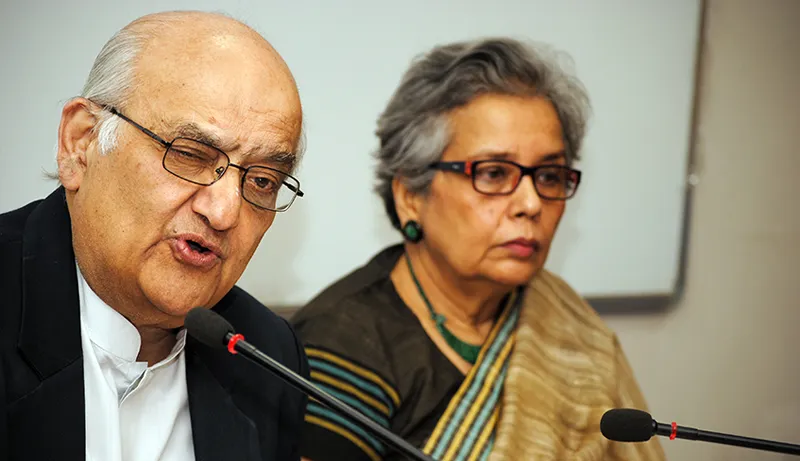The Rana Plaza disaster in Bangladesh, which had killed 1133 workers and injured more than 1800, was symbolic of a much deeper crisis, not limited to Bangladesh, according to Prof. Rehman Sobhan, chairman of the Centre of Policy Dialogue, Dhaka.

The Rana Plaza disaster in Bangladesh, which had killed 1133 workers and injured more than 1800, was symbolic of a much deeper crisis, not limited to Bangladesh, according to Prof. Rehman Sobhan, chairman of the Centre of Policy Dialogue, Dhaka.
Delivering a talk on "Bangladesh’s Rana Plaza Disaster: Perspectives on the Political Economy of Globalisation" on March 18, Prof. Sobhan said the collapse of the eightstoried Rana Plaza building, located in suburban Dhaka, was perhaps the worst industrial disaster in the country’s recorded history.
Prof. Sobhan outlined seven key issues that need to be addressed in order to find long term solutions to prevent disasters of this magnitude. These include understanding practices of mal-governance, political dimensions of the crisis, unjust social practices, economic dependency on global markets, unjust workings of the global economic order, need for long term structural reformations and taking proactive international measures alongside domestic ones.
To begin with, Prof. Sobhan highlighted that the building structure of Rana Plaza was built on illegally. The shoddy construction work was carried out without any serious regulatory oversight. This was not only a governance failure but also a lack of implementation of compliance measures by the global buyers who are the end-consumers of the production chain.
On the political spectrum, Prof. Sobhan pointed out that the interface between mal-governance and mal-politics was a critical factor in shaping the underlying governance dynamics that contributed to the Rana Plaza disaster. He said the inherent nexus between the political elite and criminals not only obscured criminal activities but also served as a means of allowing these criminal institutions to have a stake in the national economy.
From a social perspective, Prof. Sobhan outlined the compulsions which most of the workers in the industry suffered. He attributed the enormous supply and casual arrangement of labour as one key reason which not only compels the workers to work despite poor facilities, wages and lack of unions but also subsequently attracts foreign companies that seek lower overheads and obligations. He described such a practice as ’labour market flexibility’, where a person can be hired by an export firm when the market is favourable, and by the same token be fired if there is a downturn.
To further expound on the unjust nature of the economic sector, Prof. Sobhan gave an example of a shirt made in Bangladesh, which gets retailed at approximately US$ 25 at K Mart or Wal Mart in New York, with less than 1% trickling down to the local Bangladeshi sub-contractors. In order to generate a clearer understanding of the unfair economic system, he suggested that there is the need for closer examination of the distribution of 63% of the retail price acquired by global firms; something that still has not been done at the WTO, World Bank or in consultations between Bangladesh and the US government.
Delving further into the value-chain distribution of the garment industry, Prof. Sobhan explained that a Bangladeshi exporter who only secures about 8% of the retail price is tempted to maximize profits by outsourcing a fraction of his work to a cheaper sub-contractor, who is further left with only 1% of the value-chain to meet production, labour and rentals costs. This, he explained, is an important factor that has led to the proliferation of lower rental premises built with dubious construction standards as an economically attractive option for the secondary sub-contractor.
Suggesting long term measures for the aforementioned issues, Prof. Sobhan asserted the need for better governance, infrastructure building standards and provision of financial security to the subcontractors. He also mentioned that, only reforming the garment industry would not be much fruitful, as the issue stretches right from the top of the governing structure to the very bottom.
In terms of the unfair global economic structure, Prof. Sobhan stressed on the need for a dialogue between international trade governing bodies and the local government. He stated that the US earns $720 billion revenue through levying duty on Bangladeshi goods, while Bangladesh received only $200 million a year as ODA. In other words, the US can certainly show a positive humanitarian gesture by lowering duty or perhaps giving duty free access to Bangladeshi goods, which can increase the percentage share that is eventually received by the Bangladeshi producer, sub-contractors and labour.
During the question and answers session, when Prof. Sobhan was asked about the future of local exporters and their relation with the global buyers, he put forth an encouraging idea that perhaps local Bangladeshi or South-Asian exporters can play a larger proactive role by establishing themselves in global markets or becoming shareholders in global giants like Wal Mart. He further added that there should be a reduction in the number of factories from 4000-5000 to 200-300 major tier ones. This would not only subtract the low-grade unregulated sub-contractor out of the equation, but would establish major export firms that would have the potential to grow regionally and internationally by securing a larger percentage of the final retail price for Bangladeshi subcontractors and workers.
Prof. Sobhan said it was unfortunate that an incident like the Rana Plaza disaster had to act as a wake-up call for the Bangladeshi government and the international bodies to draw their attention on Bangladesh and its inherent challenges. Nonetheless, he was hopeful that if the system restructured on a domestic level and the developing nations worked collectively for a just economic system on the international arena, change was certainly possible in terms of redressing many challenges faced by production industries in Bangladesh as well as across many third-world countries.
The event by chaired by Ms Jayshree Sengupta, Senior Fellow, ORF.
(This report is prepared by Aakash Tolani, Research Intern, Observer Research Foundation, Delhi)
The views expressed above belong to the author(s). ORF research and analyses now available on Telegram! Click here to access our curated content — blogs, longforms and interviews.




 PREV
PREV

